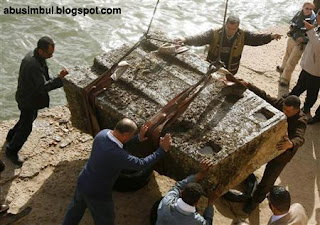 Egyptian archaeologists out Antiquities Of Red granite From the bottom of the sea Near Cleopatra's sunken palace
Egyptian archaeologists out Antiquities Of Red granite From the bottom of the sea Near Cleopatra's sunken palace Experts said Shows that the impact of well The impact of Pharaonic architecture In Greek and Roman eras.
And the cluster of stone Dating back to the year 30 BC Near the end of the Hellenistic era , Which weighs nine tons And a length of 2.25 m Was part of the temple of the ancient Egyptian gods Isis.
 And Harry said Zalas Greek head of the mission that discovered the sunken antiquities in 1998 The pharaonic style of block stone Explained the impact of ancient Egyptian architecture At the end of the rule of Cleopatra Until the early control of Romania.
And Harry said Zalas Greek head of the mission that discovered the sunken antiquities in 1998 The pharaonic style of block stone Explained the impact of ancient Egyptian architecture At the end of the rule of Cleopatra Until the early control of Romania. He also Zalas "Gate piece of architecture typical girl." And completed "Architecture in Alexandria in the Hellenistic era Greek architecture were not full. Was a Greek dynasty But used the ancient Egyptian architecture. "
He was given To that Antiquities was part Use of the temple during the reign of Cleopatra He explained Pharaonic culture that lasted until the final moments of the rule of Greece and the Roman era.
The piece was originally discovered At a depth of eight meters below the sea east of Royal Quarter in the city submerged.
He said Zalas The Temple of Isis same "It was very close to the tomb of Cleopatra." Still the actual location for the burial of Cleopatra's secret. Divers and withdraw Antiquities for days at the bottom of the sea Until they reached him to the eastern port of Alexandria Where the lift to the mainland.
It will be the cluster of stone Widget MAIN Antiquities Sunken Antiquities Museum in Alexandria
If I benefited from this information Subscribe to the RSS feed.



No comments:
Post a Comment